
Samantha Reid
Samantha is a recognized expert in American numismatics with extensive experience in trend and market analysis. She specializes in 20th century coins and collectors questions, e.g., rare issues and minting errors
Samantha is regularly published in numismatic editions and consults others on collecting and investing in valuable coins. Her work helps both novices and professionals to understand how much is a Kennedy half dollar worth and which pieces are really interesting to look at.
Connect with Samantha:



A Сherished Symbol of Time
This coin, first minted in 1964, quickly outgrew its status as a common currency and became a symbol of memory. While it is rarely seen in daily circulation, Kennedy half dollar values on the secondary market remain consistently high, especially when it comes to Kennedy half dollar silver content 90% pieces, rare minting variants, or error examples.
Well, how much is Kennedy half dollar worth? The most notable example was the unique 1964 SP68 Special Strike Kennedy half dollar that sold at Stack’s Bowers auction in 2019 for $156,000 – an all-time record for the entire series. And it’s no wonder: this year’s coins contain 90% silver, and even their base melt value Kennedy half dollar as of June 2025 is around $12.40 – 24 times the face value.
With each year passing, attention to these coins only increases. And their collectible and historical value continues to grow.
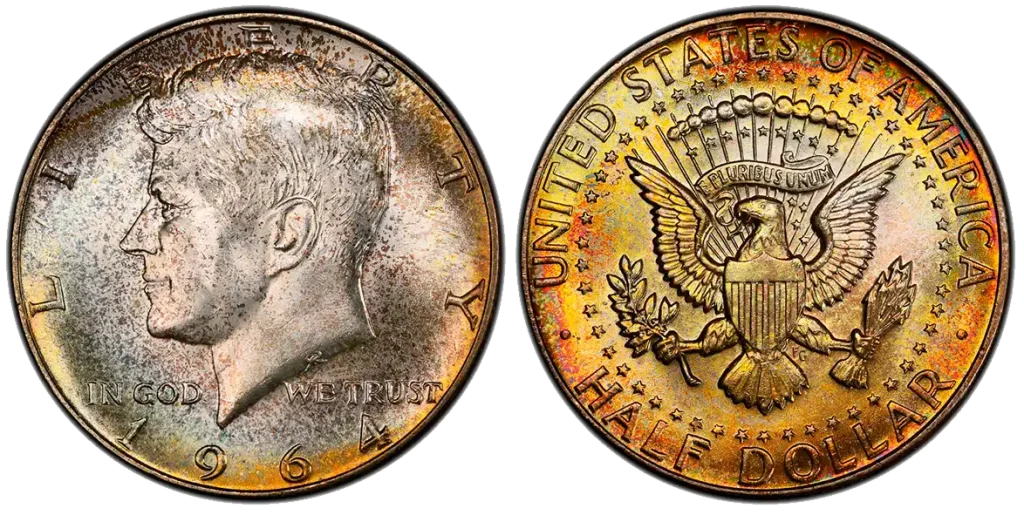
Kennedy Half Dollar Fundamentals
The Kennedy Half Dollar coin first came into circulation in 1964, just 30 days after the tragic murder of President John F. Kennedy. The idea of creating a new coin in his honor received swift support both at the government level and among Americans. The half dollar with Kennedy’s profile replaced the coin featuring Benjamin Franklin, which was stopped that same year.
This coin quickly gained symbolic value, becoming a monument to national grief, as well as an interesting collector’s item. Over time, the JFK half dollar value became an important subject for both precious metal coin investors and numismatists.
Periods and Silver Composition
The metal composition of the 50-cent coin varied depending on the year of issue. It is the year of production that directly affects the answer to the question “how much silver is in a Kennedy half dollar?” and, accordingly, its market value.
- 1964 is the fist and the most special issue among other Kennedy half dollar silver years. The series contains 90% silver and 10% copper. The weight of the coin was 12.5 grams. This is the most valuable version in terms of silver content, and an important point in understanding the silver Kennedy half dollar value.
- 1965-1970 – the coins became “lightweight” and were issued in the composition of 40% silver and 60% copper. The weight is 11.5 grams. Such specimens are also interesting for evaluation of Kennedy silver half dollar value, especially in high degrees of preservation.
- From 1971 and on – silver was completely eliminated. The coins became copper-nickel, which sharply reduced their metal value. However, even among them there are interesting specimens, which are included in the Kennedy half dollar valuable coins list.
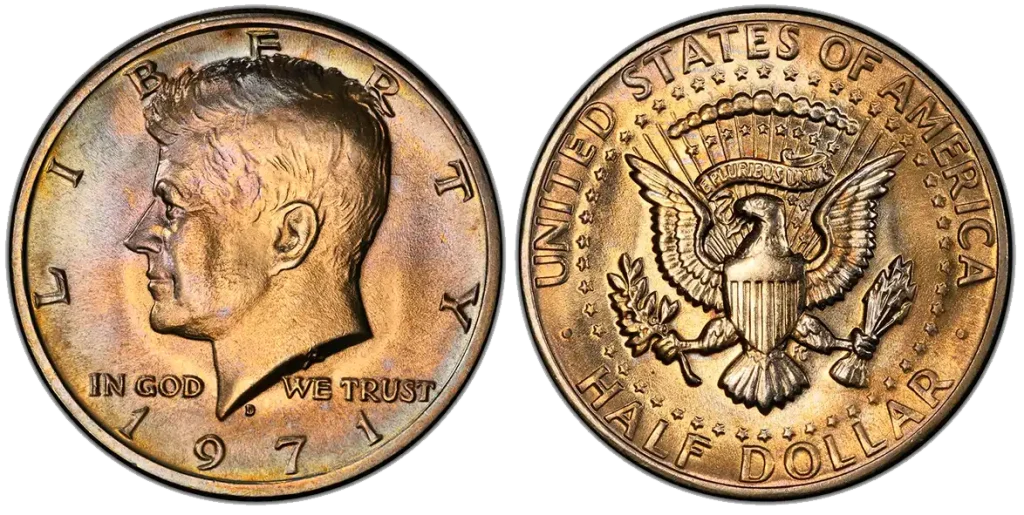
It is important to note that these coins were never minted in gold for everyday circulation. But if you are interested in collectible gold Kennedy half dollar issues, check out the 2014-W Gold 50-cent example, a special commemorative version issued for the 50th anniversary of the half dollars. It contains ¾ ounce of pure gold (99.99%) and is an official limited edition of the US Mint.
A Few Words about Coins Design
The obverse design, which shows the profile of John F. Kennedy, was created by Mint designer Gilroy Roberts. He used his own work on a commemorative medal issued shortly after the President’s death as the basis for the design. The image is austere and restrained – in the spirit of state symbols.
The reverse, depicting the U.S. coat of arms – an eagle with a shield, olive branch and arrows, surrounded by fifty stars – was designed by another famous designer, Frank Gasparro. Under the eagle’s right paw, you can notice the tiny letters FG – his initials. They are seen on almost all issues of the coin since 1964.
Today, interest in Kennedy coins does not wane. Many collectors carefully study the Kennedy half dollar value by year, as it depends on the year, type of minting, and even the mint.
Silver Value Breakdown
As has already become clear, silver content is one of the key factors in Kennedy half dollar valuation. Even coins with moderate traces of circulation from 1964-1970 can be valuable because of the precious metal in their composition. But here it is important to distinguish the Kennedy half dollar melt value and market worth: the former is based on the metal price, while the latter depends on the demand, condition and rarity of the coin.
Below for your reference is the Kennedy half dollar value chart, where you can see the difference between face value, melt value and real market cost for collectors depending on the condition of the coin.
| Year | Composition | Silver Content | Weight | Melt Value (when ~$29/oz) | Market Cost (XF–MS65) |
|---|---|---|---|---|---|
| 1964 | 90% silver | ~11,25 g | 12.5g | $12.40 | $15 – $60+ |
| 1965–1970 | 40% silver | ~4,6 g | 11.5g | $5.07 | $6 – $25+ |
| 1971+ | No silver | 0 g | 11.34g | $0.10 (just for metal) | $0.50 – $3 (depending on grade) |
Thus, even ordinary coins can be attractive for investors – JFK silver half dollar value is supported by a significant content of precious metal. This is especially noticeable in periods of rising silver prices.
How Much Is a JFK Half Dollar Worth: Top 5 Extraordinary Examples
Some pieces reached impressive prices at auction. Let’s take a closer look at some 50-cent pieces that became true legends among collectors. They demonstrate what John F Kennedy half dollar value is in practice – a combination of rarity, condition and unique features.
1964 SP68 Special Strike
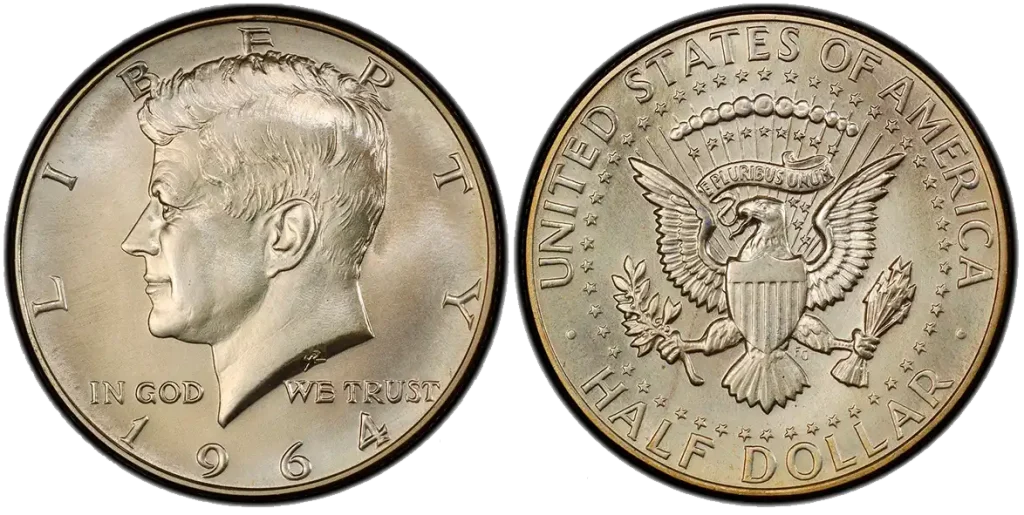
- Format and Year: 1964, Special Strike (SP)
- Grade: SP68 (PCGS)
- Quantity known: 12 in total
- Record price: $156,000, Stack’s Bowers, August 2019
This uncirculated Kennedy half dollar is among the rarest of all known. The special minting format (intermediate between MS and PF, on specially prepared dies), as well as the almost perfect condition make this coin unique. It possesses exceptionally clear details, gloss and is rightfully considered an elite piece of numismatics.
1964 Accented Hair Proof
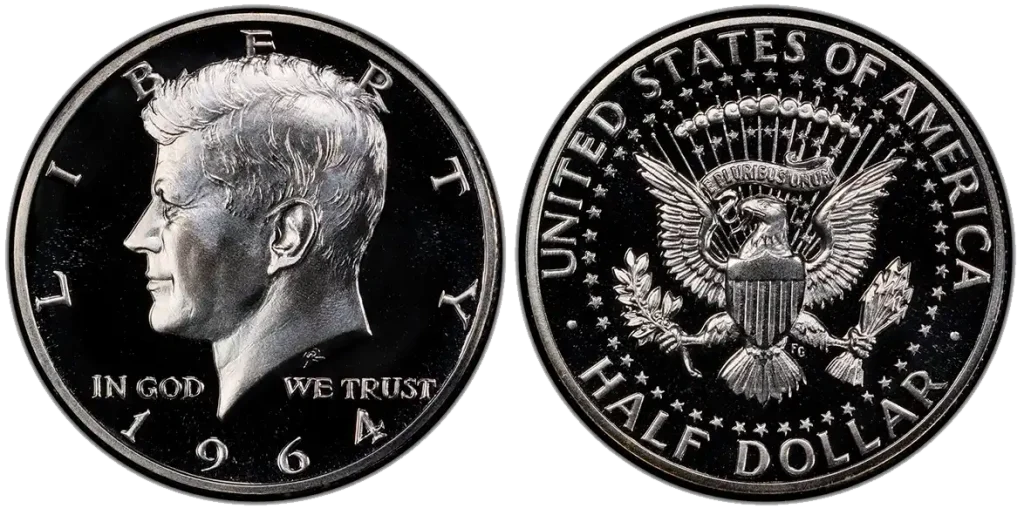
- Format and year:1964, Proof
- Trait: extra strand above the ear on obverse
- Grade: PR69 DCAM (PCGS)
- Record Price: $45,600, Heritage Auctions, July 2016
Accented Hair is one of the most famous early varieties of proof versions. The special feature of the design is the emphasized texture of the hair (which was later changed at the request of Jacqueline Kennedy). The presence of the extra strand, the mirrored surface and the deep contrast between it and the clear matte design elements (deep cameo effect) make this coin particularly desirable to collectors.
1968-S Proof Deep Cameo
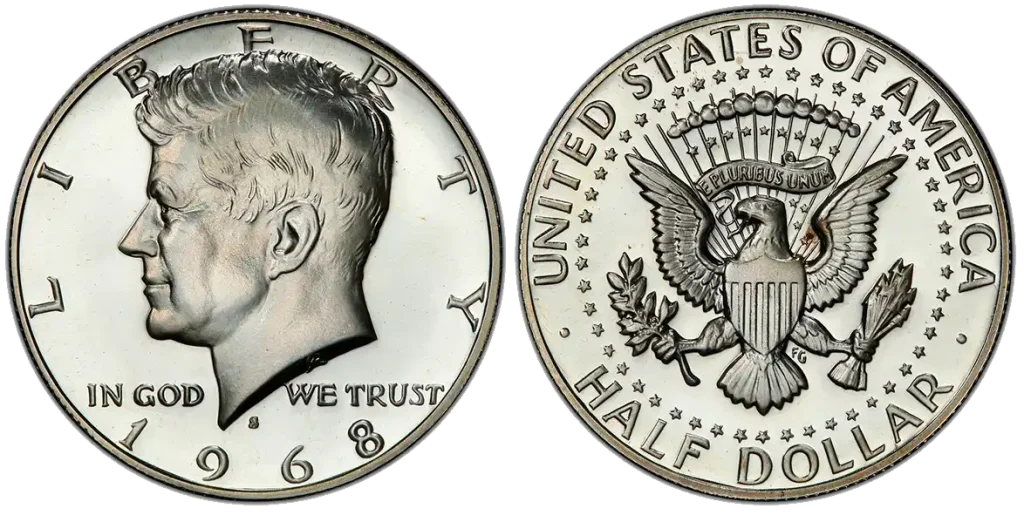
- Format and year: 1968, Proof
- Grade: PF70 DCAM
- Record Price: $24,000, Stack’s Bowers, June 2023
Pieces of 1968 were first minted in San Francisco with “S” mint mark on Kennedy half dollar. Proofs with perfect contrast, deep luster and high contrast between the surface and other details are very rare. This particular PF70 specimen received tremendous value among collectors who know firsthand what is a Kennedy half dollar worth in perfect condition.
1970-D Low Mintage
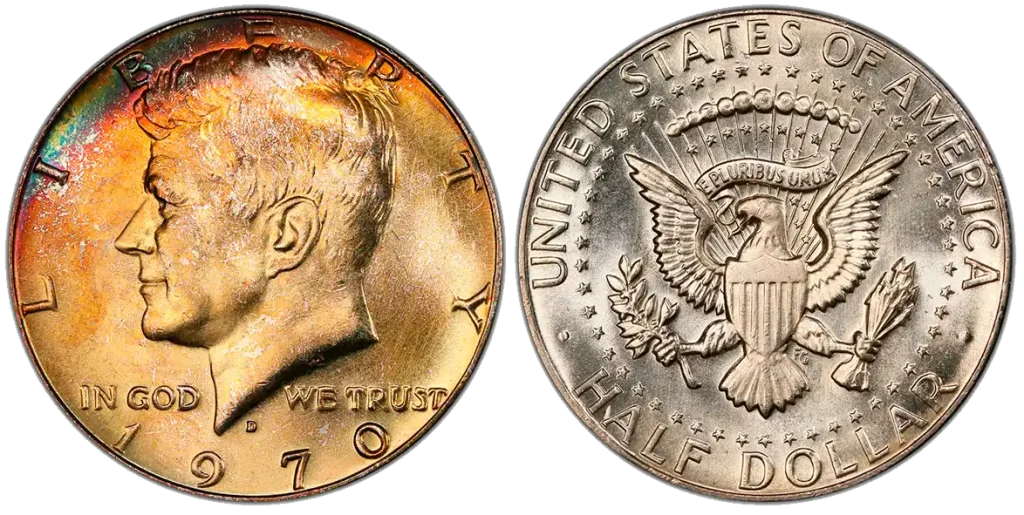
- Year: 1970
- Mint: Denver (D)
- Mintage: only 2.15 million
- Grade: MS67
- Record Price: $13,000, eBay, April 2018
This issue was the last one minted in 40% silver, so this 40 Kennedy half dollar value can be extremely high for some reasons: the coin did not enter circulation, but was included in the annual Mint Sets, which means that access to specimens in perfect condition is limited. Such coins can even reach five-figure sums at auctions, especially if they have the original surface and full detail.
1972-D No FG
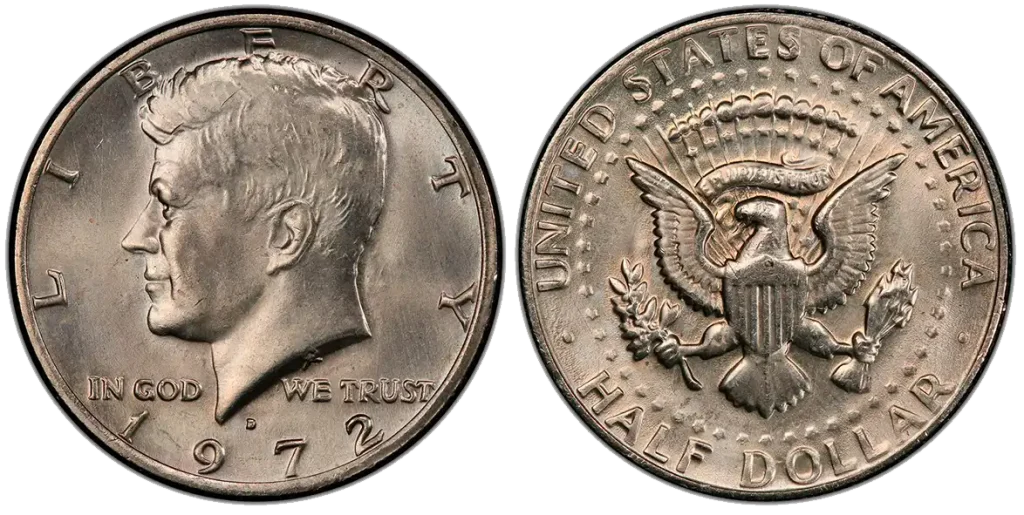
- Year: 1972
- Mint: Denver (D)
- Feature: missing designer’s initials FG on reverse
- Grade: MS65
- Estimated market price is $1,000+
Erroneous coins are rare among others. In this particular case, the initials of designer Frank Gasparro (FG) are missing. This was caused by excessive polishing of the stamp. The Kennedy half dollar errors list includes this particular piece as one of the most recognizable and sought after.
Bicentennial Kennedy Half Dollars (1776–1976)
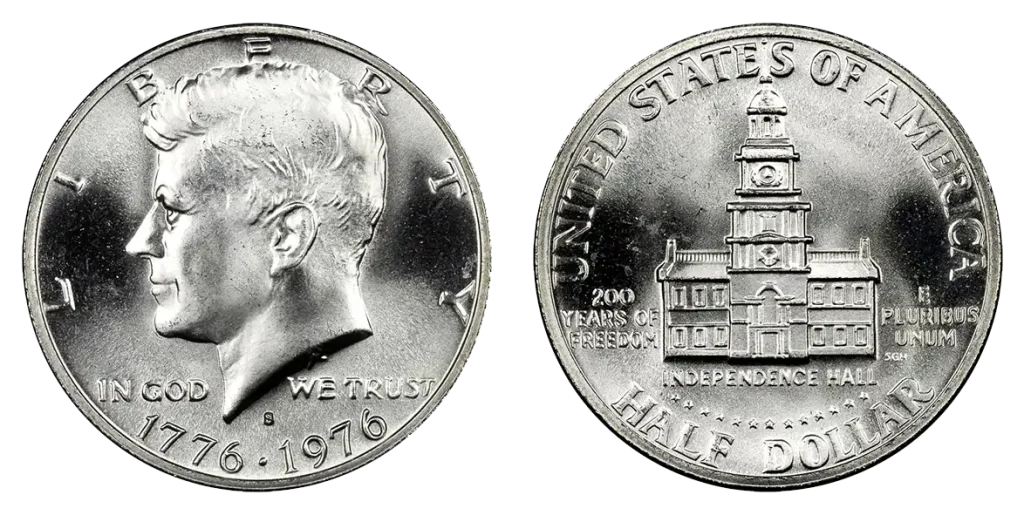
The JFK bicentennial half dollar is one of the most recognizable issues of the series, commemorating the 200th anniversary of the signing of the Declaration of Independence. In 1975-1976, the regular dates on coins were replaced by the double date “1776-1976” and the reverse was completely redesigned. These coins were minted for both circulation and collector purposes, and today the Kennedy half dollar bicentennial remains a popular subject among numismatists and investors.
Design Features
- Obverse: unchanged – portrait of John F. Kennedy by Gilroy Roberts.
- Reverse: depicts Independence Hall in Philadelphia, where the U.S. Declaration of Independence was adopted. The author of the design is Seth G. Huntington. The reverse also bears the signature “200 Years of Freedom” and the double date 1776-1976, which is unique to the entire series.
- Composition: Ordinary coins (with copper-nickel alloy) went into circulation. Collectibles (with alloy with 40% silver content) were also issued and included in special sets from the mint. Regular coins are often found in circulation, but as you can imagine, bicentennial Kennedy half dollar value depending on condition and composition, can vary greatly.
Kennedy Bicentennial Half Dollar Value Chart (current as of June 2025):
| Type of coin | Composition | Silver (oz) | Melt Value | Cost (MS65) |
|---|---|---|---|---|
| Ordinary (circulating) | copper-nickel | 0 | $0 | $0.50 – $5 |
| Collectible (40% silver) | silver alloy | ~0.1479 | ~$5.07 | $10 – $25+ |
Interesting fact: Coins 1776-1976 with high specular luster and sharp details are sometimes mistakenly considered as proof. However, some of these pieces are specimen strikes or the first coins with fresh stamps that are not part of official proof sets. They have no official designation but are valued by collectors over ordinary coins.
Critical Error Coins
Minting errors can turn an ordinary coin into a legend. Some examples from Kennedy half dollar errors list are valued far above their face value, precisely because of unusual minting features. Below are four of the most famous errors:
1964 DDO/DDR
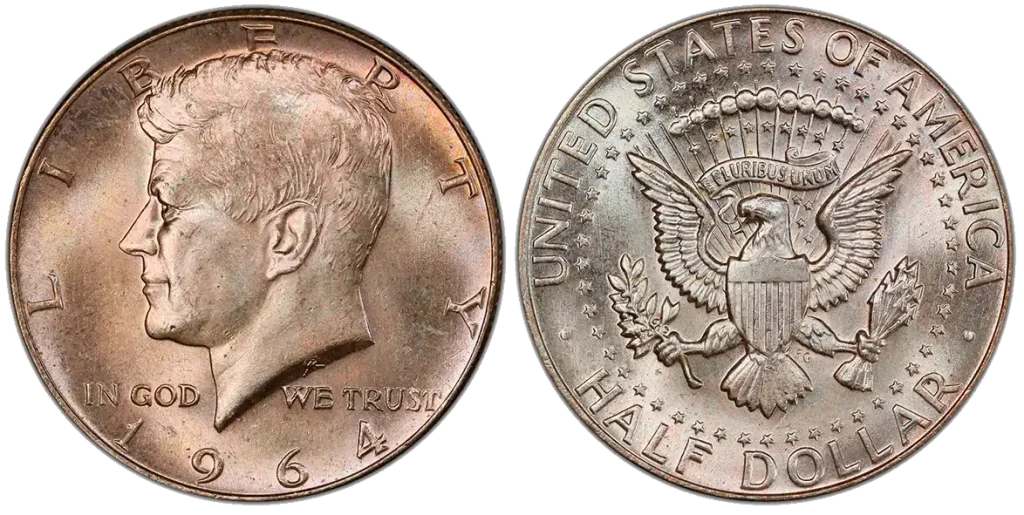
- Have duplicate elements on the obverse or reverse due to die offset.
- The doubling is most often visible on the inscriptions “LIBERTY”, “IN GOD WE TRUST” and the date.
- Depending on the condition, these pieces can cost from $35 to $160.
1982-P No FG
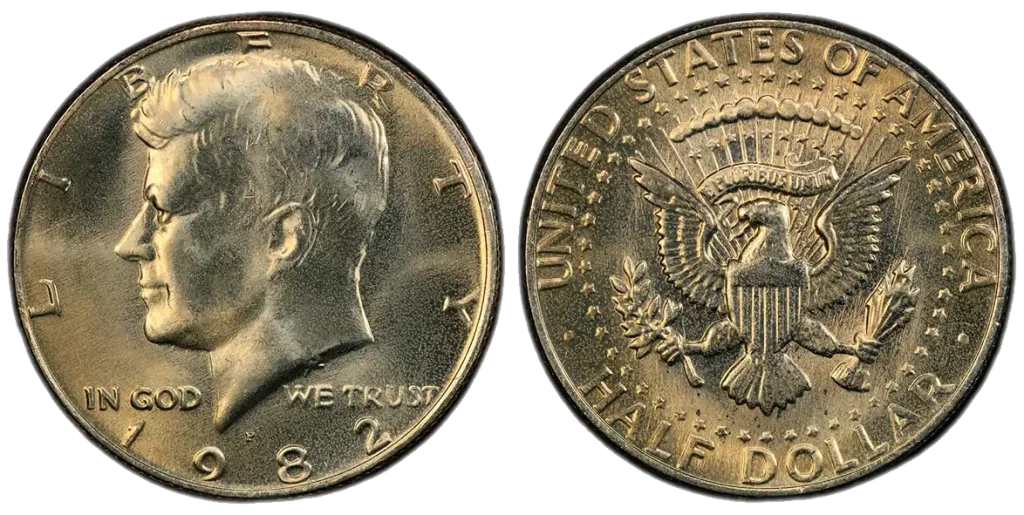
- The reverse is missing designer Frank Gasparro’s initials (“FG”), which are usually located under the eagle’s right paw.
- The error occured because of over-polishing of the stamp.
- Rarely found, priced from $8 to $40.
1998-S Matte Finish
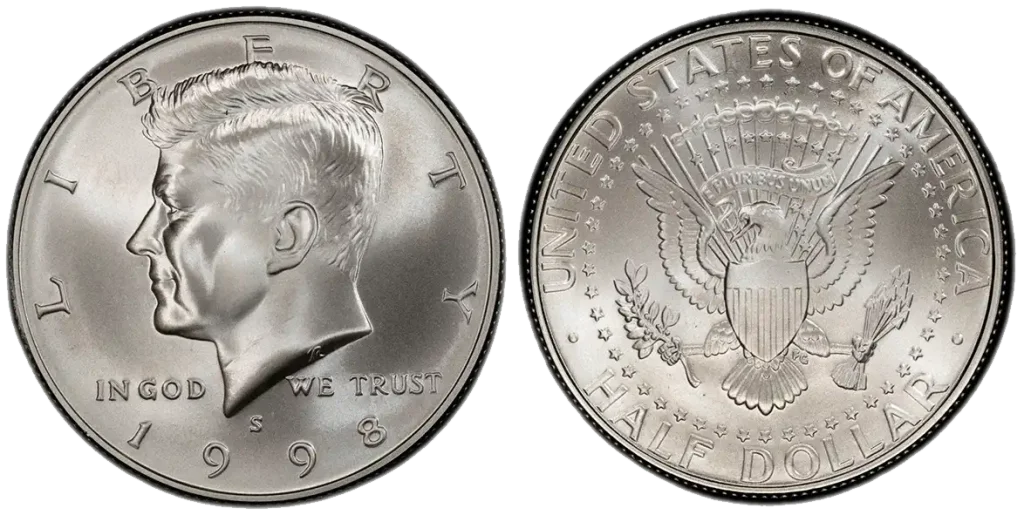
- Issued in a limited edition of 62,000 pieces only as part of the Kennedy Collector’s Set.
- Instead of the shiny, mirror-like surface of regular proof, the coin has a matte texture and deep detail.
- Market value is $100 and up.
Off-Center Strikes
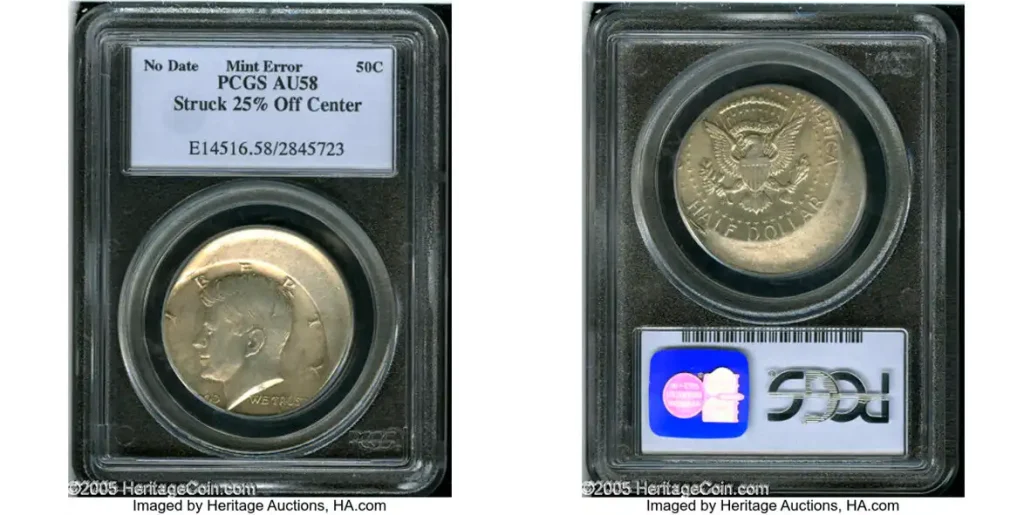
- The coin is minted with an off-centered design (often by more than 10%).
- The stronger the displacement, the higher the value, especially if the denomination and portrait are clearly visible.
- Depending on the degree of displacement, the price may be 5 times the face value or more.
Key Value Factors: What Makes a Kennedy Half Dollar Worth Collecting?
Mint Mark Guide
When determining the value of any coin, it is important to consider more than the year of issue or famous minting errors, but also other significant parameters. One of them is the mint mark.
On Kennedy half dollar mint mark is placed to the right of Kennedy’s neck. This mark is the first indicator of the rarity and place of origin of the piece.
Denver (D mint mark) produced both regular coins and Kennedy half dollar key date issues such as 1970-D and 1983-D. Denver coins are often found in excellent condition.
San Francisco (S mark) minted only proof coins for this series. It is known for limited editions, including 1998-S Matte Finish and silver commemorative versions.
Philadelphia (no mark) minted coins for mass circulation with no mark until 1980. Valuable errors and early rare issues are found among them.
Grading Impact on Value
The second key parameter and deciding factor in the price is the condition of the coin. Below you can see an approximate breakdown of values depending on coin grade:
| Grade | Description | Average price on the market |
|---|---|---|
| MS-60 | Faint gloss, scratches possible | $10–$50 |
| MS-65 | Excellent condition, clear relief, minimal marks | $100–$500+ |
| PR-69 | Almost perfect specimen | $300–$1000+ (depending on date and issue) |
Prices are for mass issues. Rare varieties and in exceptional condition may have significantly higher grades.
Remember: two coins of the same date and mint can differ in price ten times just because of the grade.
How to Identify Kennedy Half Dollar
The identification of a coin is the first step to understanding its value. You can start by checking the basics:
- Check the year and mint mark. Due to this you can understand whether the coin is from rand whether the coin belongs to a rare date or common issue.
- Assess the condition. It’s important to carefully inspect the surface: scuffs, scratches, and the presence of original luster.
- Use a proven tool. Use Coin ID Scanner – a modern AI coin identifier to check the coin’s origin, historical background and even the current market value. What is more, the app helps you to conveniently and securely maintain a digital database of your collection – no more paper records and unnecessary confusion.
Finally, Kennedy Half Dollar coins deserve the attention of all: collectors and ordinary people who just want to understand their value. Given the range of prices, the importance of year of issue and condition, it makes sense to evaluate a coin carefully – especially if you got it by accident or long ago.